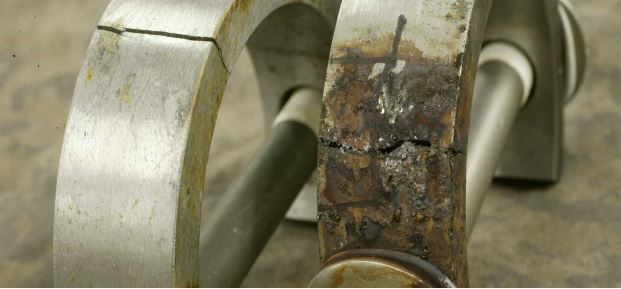Thermal fatigue is a fatigue failure with macroscopic cracks resulting from cyclic thermal stresses and strains due to temperature changes, spatial temperature gradients, and high temperatures under constrained thermal deformation. Thermal fatigue may occur without mechanical loads. The constraints include external ones (e.g., bolting load) and internal ones (e.g., temperature gradient, different thermal expansion due to different materials connected). Compressive stresses are produced by the bolting load at high temperatures, or generated in the material having high coefficient of thermal expansion. Tensile stresses are produced when the component cools, or generated in the material having low coefficient of thermal expansion. Thermal stresses are produced by cyclic material expansion and contraction when temperature changes under geometric constraints. A crack may develop after many cycles of heating and cooling. The failure indicator or criterion of thermal fatigue is usually strain rather than stress. Thermal fatigue life is determined mainly by material ductility rather than material strength.
Thermal fatigue can be HCF or LCF, depending on the magnitude of thermal stress compared to the yield strength of the material. Thermal fatigue life can be predicted by using either stress (for HCF) or plastic strain (for LCF) as a criterion. The thermal fatigue in engine applications usually refers to the thermo-mechanical fatigue problems where thermal fatigue plays a dominant role.
Anisothermal fatigue can sometimes be more damaging than isothermal fatigue. Isothermal fatigue occurs when tension or compression cycles are imposed at a constant temperature. Anisothermal fatigue occurs when the component temperature and strain vary simultaneously. An engine may operate at isothermal conditions in steady state for a long period of time (e.g., in stationary power application or durability testing). Automotive engines often encounter anisothermal fatigue during largely varying thermal cycles. Anisothermal fatigue is more complex to model than isothermal fatigue because of the varying temperatures within the cycle.
The mechanical properties of the material deteriorate with time when the material is exposed above certain level of temperature. The ultimate strength of the material decreases due to the aging of mechanical properties at high temperatures. This aggravates the occurrence of plastic deformation in thermal fatigue. Experimental work has confirmed that the maximum component temperature in a thermal cycle (e.g., cycling from high engine speed-load modes to low speed-load modes) has a much greater influence on thermal fatigue life than the minimum or cycle-average component temperatures. The maximum temperature is also more important than the temperature range of the cycle for the reason that the fatigue-resistance property of the material deteriorates quickly at high temperatures. This means in engine system design the maximum gas temperature and heat flux should be used as design constraints in most cases.
Thermal fatigue life can be improved by reducing the temperature and temperature gradient or alleviate the geometric constraints. For example, reducing metal wall thickness can reduce the gas-side surface temperature and thermal expansion hence increase fatigue life. Using slots or grooves in the component may eliminate the constraints for thermal expansion. for more information see https://doi.org/10.1533/9780857090836.1.113


